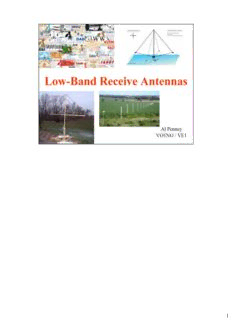
Low Band RX Antennas - SMART 2017 Presentation PDF
Preview Low Band RX Antennas - SMART 2017 Presentation
1 Aircraft detection system from the 1920s. I’ll discuss the following antennas today. I won’t be talking about arrays of verticals, or the new Shared Apex Loop - There are many specialized RX antennas out there, and I can’t cover them all today! George VY2GF asked me to deliver this presentation on receive antennas. I found a picture of George when he was a young Ham…. 3 This is Harold H. Beverage at his Amateur Radio Station. Possibly at the University of Maine around 1915. Most people think of Beverage antennas when they think of lowband receive antennas, but as we’ll see today, there are others out there that offer good performance, even on small city lots. 4 For a transmit antenna, we want maximum possible field strength in a given direction (or directions) at the most useful elevation (wave) angles. We cannot tolerate unnecessary power loss in a transmit antenna, because any amount of transmitting loss decreases signal-to-noise ratio at the distant receiver. Antenna efficiency is an important issue for transmitting. It is obvious that for a given elevation angle and direction the highest gain antenna will deliver the strongest signal to the target area. We really do not care if we are being heard in other directions (areas) or not, we are only interested in the target direction. A receiving antenna on the other hand has a different design priority. The goal is obtaining a signal that can be read comfortably, which means having the minimum possible amount of QRM and noise. The important issue when receiving is signal-to-noise ratio (S/N). The receiving antenna providing the best performance can and will be different under different circumstances, even at the same or similar locations. There is no such thing as a universal “best low-band receiving antenna.” An example might better illustrate the concept: 5 6 7 8 There are a few things we have to keep in mind: 1.) If noise is not evenly distributed (which is often the case) performance will depend on the gain difference between desired signal direction (azimuth and elevation) to gain in the direction of noise(s). A 20dB null on the noise compared to gain in the desired signal direction will actually improve S/N ratio by 20 dB, if the noise from the null direction totally dominates all other noises. 2.) If noise arrives primarily from the same direction and angle as the desired signal (and assuming polarization of signals and noise is the same), there will be no S/N improvement. 3.) If noise originates in the near field of the antenna, all bets are off. Anything can happen. 9 10
Description: